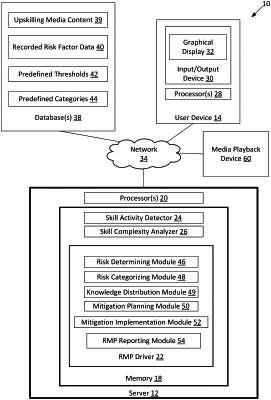| CPC G06Q 10/06395 (2013.01) [G06F 16/26 (2019.01); G06Q 10/063114 (2013.01); G06Q 10/0635 (2013.01)] | 4 Claims |

|
1. A computer-implemented method, comprising:
generating a user interface using a computing application;
determining, using a skill activity detector, a workforce skill activity type of a plurality of workforce skill activity types associated with the computing application to provide a determined workforce skill activity type, wherein providing the determined workforce skill activity type includes detecting, with the skill activity detector, that a feature of a plurality of features of the user interface generated by the computing application is being used, the feature being associated with the determined workforce skill activity type, and another feature of the plurality of features being associated with another workforce skill activity type of the plurality of workforce skill activity types;
determining, using a skill complexity analyzer, a complexity of a workforce skill corresponding to the determined workforce skill activity type, including:
measuring and recording, using the skill complexity analyzer, a magnitude of processing power used by one or more computer processors to run the computing application, the computing application being associated with the workforce skill; and
determining and recording, using the skill complexity analyzer, a frequency with which source code or a script that runs the computing application associated with the workforce skill is modified, the workforce skill requiring use of computer software;
determining, based on at least three factors, a knowledge risk associated with the workforce skill, the at least three factors including the determined workforce skill activity type, the magnitude of the processing power, and the frequency;
categorizing, based on the at least three factors, the knowledge risk in a risk category selected from a set of predefined knowledge risk categories;
assigning a risk level to the knowledge risk based on the risk category;
automatically selecting and implementing, based on the risk category and the determined workforce skill activity type, an upskilling recommendation for reducing the knowledge risk, including:
automatically updating a calendar to include an invitation to a training session associated with the upskilling recommendation;
automatically identifying, based on the upskilling recommendation, a digitally stored training media content item; and
automatically generating a link to the digitally stored training media content item;
generating, using one or more graphical user interfaces:
visual risk indicia that visually indicate the knowledge risk, the risk category, and the risk level; and
a graphical element, the graphical element including the link and being selectable to play the digitally stored training media content item;
receiving a selection of the graphical element; and
in response to receiving the selection, playing, with a media playback device, the digitally stored training media content item.
|